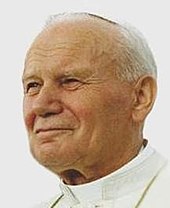භාග්යවන්ත ධූරයට එසවීම
මෙම ලිපිය පරිවර්තනය කළ යුතුය කරුණාකර මෙම ලිපිය සිංහල භාෂාවට පරිවර්තනය කිරීමෙන් දායකවන්න. |
Beatification (from Latin beatus, "blessed") is a recognition accorded by the Catholic Church of a dead person's entrance into Heaven and capacity to intercede on behalf of individuals who pray in his or her name (intercession of saints). Beatification is the third of the four steps in the canonization process. A person who is beatified is in English given the title "Blessed".

History
සංස්කරණයSince the Catholic Church reform of 1983, one miracle must be believed to have taken place through the intercession of the person to be beatified, though the medical investigations of the Church are privately conducted and therefore subject to speculation about their methods.[1][2]
The requirement of a miracle is not necessary for those who have died a martyr, as their sanctity is already evident because they were killed distinctly out of hatred for the faith ("odium fidei"). More about the process can be found in the article on canonization.
The feast day for a Blessed person is not universal, but is celebrated only in regions where the person receives particular veneration. For instance, Saint Kateri Tekakwitha was honored in the United States of America and Canada during her time as Blessed. The person may also be honored in a particular religious order. For instance, veneration of John Duns Scotus is found in the Archdiocese of Cologne, Germany, and among the Franciscans and other places. Similarly, veneration of the Blessed Chiara Badano is particular to the Focolare movement, and also demonstrates that, contrary to popular opinion, beatification may take place within a short time after the death of an individual (in this case, just twenty years).
Beatification practices under the Popes
සංස්කරණයPope John Paul II (18 May 1920 – 2 April 2005) markedly changed previous Catholic practice of beatification. By October 2004, he had beatified 1340 people, more than the sum of all of his predecessors since Pope Sixtus V (1585–1590), who established a beatification procedure similar to that used today. John Paul II's successor, Pope Benedict XVI, removed the custom of holding beatification rites in the Vatican with the Pope presiding; they can now be held where the subject lived with the Cardinal Prefect of the Congregation for the Causes of Saints[3] designated to preside over the ceremony as Papal Delegate. The Pope himself can still preside, as happened on 19 September 2010, when Benedict XVI beatified John Henry Newman in Cofton Park, Birmingham, on the last day of his visit to the United Kingdom. Benedict XVI also personally celebrated the Beatification Mass for his predecessor, John Paul II, at St. Peter's Basilica, on the Second Sunday of Easter, or Divine Mercy Sunday, on 1 May 2011, an event that drew more than a million people.
Cultus confirmation
සංස්කරණයCultus confirmation is a somewhat different procedure, where the church recognizes a local cult of a person, asserting that veneration of that person is acceptable. Such a confirmation is more an official sanctioning of folk Catholicism than an active step in a canonization procedure, but the object of the cult may equally be addressed as "Blessed."[4]
Notes
සංස්කරණය- ^ Foster, Peter (5 September 2007). "Mother Teresa 'miracle' patient accuses nuns". The Daily Telegraph.
- ^ "Pope paves way to beatification of John Paul II". BBC News. 14 January 2011.
- ^ There have, however, been occasions where instead a Cardinal from the local region was put in place.
- ^ "Patron Saints Index Definition: Cultus Confirmation". Catholic-forum.com. සම්ප්රවේශය 2013-03-26.
References
සංස්කරණය- Vatican website, with new procedures
- "The Process of Becoming a Saint" සංරක්ෂණය කළ පිටපත 2014-02-10 at the Wayback Machine – article from the Arlington Catholic Herald explaining the history of the process of becoming a saint
- "Beatification and Canonization". Catholic Encyclopedia.
- "The Blessed". Catholic Encyclopedia. New York: Robert Appleton Company. 1913.
- This article incorporates text from a publication now in the public domain: Catholic Encyclopedia. New York: Robert Appleton Company. 1913.
External links
සංස්කරණය- List of all Blesseds in the Catholic Church සංරක්ෂණය කළ පිටපත 2014-02-04 at the Wayback Machine by GCatholic.org.